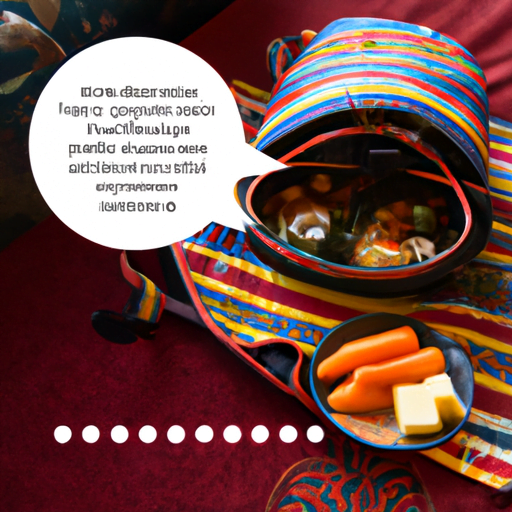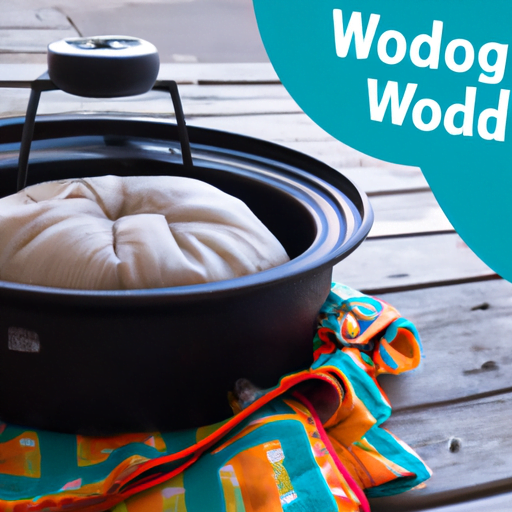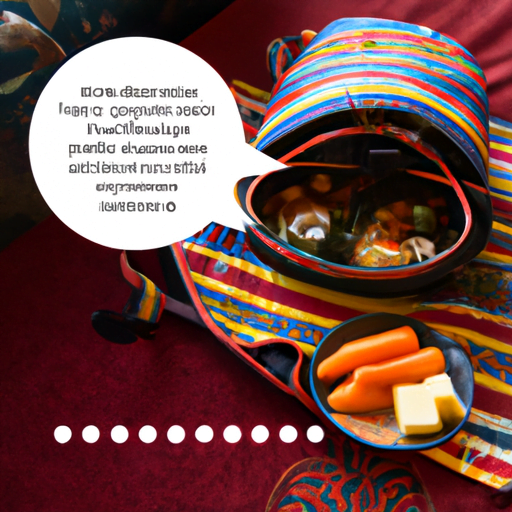So, have you ever thought about what it would be like to live off the grid? You know, being completely self-sufficient and living in harmony with nature. Well, if you have, then you probably know that one of the challenges of off-grid living is finding alternative ways to cook your food without relying on electricity or gas. That’s where the Wonderbag slow cooker comes in.
The Wonderbag is a simple but ingenious invention that lets you cook food without electricity or gas. It’s basically a portable and insulated bag that works as a slow cooker. All you have to do is heat up your food in a pot on a stove or fire, then place the pot inside the Wonderbag. The insulating material of the bag keeps the heat trapped inside, allowing the food to continue cooking for hours. It’s like having your very own off-grid crockpot!
You might be wondering how the Wonderbag works exactly, and what makes it so special. Well, the secret lies in its design. The bag is filled with insulating materials that keep heat in, which means you can cook your food for long periods of time without having to use any additional fuel. Plus, the Wonderbag is incredibly versatile. It’s not just for slow cooking, you can also use it to keep food warm, bake bread, or even make yogurt. And the best part? It’s completely portable, so you can take it with you wherever you go. In our upcoming article, we’ll dive deeper into the many benefits and uses of the Wonderbag slow cooker, so stay tuned to learn more! The Wonderbag slow cooker has been gaining popularity in recent years as the ultimate off-grid cooking solution. But before we dive into the details of this innovative product, let’s first discuss the concept of off-grid living.
Defining Off-Grid Living
Off-grid living refers to a lifestyle where individuals or communities are completely independent from public utilities such as electricity, water, and gas. Instead, they rely on self-sustainable systems to meet their daily needs. This can include generating their own power through solar panels or wind turbines, collecting rainwater for consumption and irrigation, and using alternative cooking methods that do not require traditional energy sources.
Advantages of Off-Grid Living
There are several advantages to embracing off-grid living. First and foremost, it allows individuals to reduce their environmental impact by decreasing their reliance on fossil fuels and lowering their carbon footprint. Off-grid living also promotes self-sufficiency and resilience, as individuals become less dependent on external sources for their basic needs. Additionally, off-grid living can lead to financial savings in the long run, as individuals are not burdened by monthly utility bills.
Challenges of Off-Grid Living
While off-grid living offers numerous benefits, it is not without its challenges. One of the main hurdles is the initial cost of setting up an off-grid system, which can be quite expensive. Additionally, individuals often need to adapt their lifestyle and habits to optimize energy and resource usage. This may involve making adjustments to daily routines and becoming more conscious of water and electricity consumption. Lastly, off-grid living requires a certain level of technical knowledge to effectively maintain and troubleshoot the various systems that are in place.
Now that we have a clear understanding of off-grid living, let’s delve into the world of the Wonderbag slow cooker.

Introduction to Wonderbag Slow Cooker
The Wonderbag slow cooker is a unique cooking device that was invented in South Africa by Sarah Collins. It is essentially a heat-retention cooker that allows food to continue cooking without the need for additional energy. The Wonderbag is made from durable fabric and insulation, which helps to retain heat and keep food at a consistent temperature for an extended period of time.
How Does the Wonderbag Slow Cooker Work?
The Wonderbag slow cooker operates on a simple principle. After bringing a pot of food to a boil on a traditional stove or fire, the pot is then placed inside the Wonderbag. The bag is tightly sealed, and the insulation helps to trap the heat that is generated during the initial cooking process. The retained heat continues to cook the food for up to 12 hours, resulting in perfectly tender and flavorful meals.
Benefits of Using a Wonderbag Slow Cooker
Using a Wonderbag slow cooker offers numerous benefits, particularly for off-grid living. First and foremost, it significantly reduces the amount of energy required for cooking. By eliminating the need for constant heat, the Wonderbag helps to conserve gas, electricity, or any other fuel source that would otherwise be consumed during the cooking process. This not only saves money in the long run but also reduces the environmental impact associated with cooking.
Another advantage of the Wonderbag slow cooker is its versatility. It can be used to cook a wide variety of dishes, including soups, stews, rice, beans, and even desserts. The gentle and slow cooking process enhances the flavors and textures of the food, resulting in delicious and nutritious meals.
Additionally, the Wonderbag slow cooker promotes convenience. Once the pot is placed inside the bag and sealed, there is no need to continuously monitor the cooking process. This allows individuals to go about their day without having to worry about stirring, adjusting temperatures, or the risk of food burning. The Wonderbag also retains heat so well that it can even keep food warm for several hours after the cooking process is complete, making it perfect for potlucks or picnics.
Using a Wonderbag slow cooker also supports social and economic empowerment. The company behind the Wonderbag is committed to empowering women in developing countries. By providing them with access to safe and efficient cooking methods, the Wonderbag enables these women to spend less time gathering firewood or cooking over open flames. This gives them the opportunity to pursue education, employment, and other activities that can improve their quality of life.
Now that we have explored the basics of the Wonderbag slow cooker, let’s discuss how to use it effectively.

How to Use a Wonderbag Slow Cooker
Using a Wonderbag slow cooker is incredibly simple and straightforward. Here is a step-by-step guide to help you get started.
Preparing the Ingredients
- Choose your recipe: Select a recipe that is suitable for slow cooking, such as soups, stews, or casseroles.
- Prep your ingredients: Chop vegetables, trim meats, and prepare any additional components required by your recipe.
- Cook the initial stage: Place the pot with the ingredients on a stovetop or fire and bring it to a boil. Allow the food to cook for the specified amount of time according to your recipe.
Cooking with the Wonderbag Slow Cooker
- Transfer the pot: Carefully remove the pot from the stovetop or fire and place it inside the Wonderbag.
- Seal the bag: Tightly seal the Wonderbag by pulling the drawstrings or securing the Velcro closure. Ensure that the bag is completely sealed to retain the heat effectively.
Tips and Tricks for Using the Wonderbag Slow Cooker
- Choose the right pot: The pot you use should have a tight-fitting lid to prevent heat from escaping. Heavy-duty and well-insulated pots work best with the Wonderbag.
- Use the right amount of liquid: Since the Wonderbag relies on trapped heat for cooking, it is essential to ensure that you have enough liquid in your recipe. This will prevent the food from drying out during the cooking process.
- Consider preheating the pot: Before transferring the pot to the Wonderbag, you can preheat it by pouring boiling water into it and letting it sit for a few minutes. This helps to retain heat and shorten the overall cooking time.
Now that you know how to use the Wonderbag slow cooker, let’s explore some mouthwatering recipes that you can try.
Recipes for the Wonderbag Slow Cooker
The Wonderbag slow cooker opens up a world of culinary possibilities. Here are a few recipes to get you started:
Vegetarian Recipes
- Hearty Vegetable Stew: A medley of seasonal vegetables slow-cooked in a flavorful broth, perfect for chilly evenings.
- Lentil Curry: Fragrant spices, lentils, and coconut milk come together to create a creamy and satisfying plant-based curry.
- Ratatouille: Layers of zucchini, eggplant, bell peppers, and tomatoes cooked in a rich tomato sauce, bursting with summer flavors.
Meat-based Recipes
- Beef Stew: Tender chunks of beef simmered with root vegetables and aromatic herbs for a comforting and filling meal.
- Pulled Pork: Slow-cooked pork shoulder seasoned with a blend of spices and served on a bun with tangy barbecue sauce.
- Moroccan Chicken Tagine: Succulent chicken thighs cooked with apricots, olives, and a medley of warm spices, resulting in a fragrant and flavorful dish.
Dessert Recipes
- Apple Cinnamon Cobbler: Tender apples baked with a buttery cinnamon crumble topping, perfect for a cozy dessert.
- Chocolate Fondue: A decadent treat of melted chocolate, served with an array of dippable fruits and cookies.
- Berry Bread Pudding: Day-old bread soaked in a mixture of eggs, milk, and fresh berries, then baked to perfection.
These recipes are just the tip of the iceberg when it comes to using the Wonderbag slow cooker. Feel free to experiment and adapt your favorite recipes to this unique cooking method.
While the Wonderbag slow cooker offers numerous benefits, it is essential to consider its impact on off-grid living and sustainability as a whole.
Saving Energy with the Wonderbag Slow Cooker
The Wonderbag slow cooker is not only a convenient and versatile cooking solution but also a tool for saving energy and reducing our environmental impact. Here are a few ways in which the Wonderbag promotes sustainability:
Reducing Electricity Usage
Traditional cooking methods, such as using an oven or stovetop, typically require a significant amount of electricity. By utilizing the Wonderbag slow cooker, individuals can significantly reduce their electricity consumption, leading to energy savings and a lower carbon footprint.
Decreasing Carbon Footprint
By reducing the need for traditional energy sources, the Wonderbag slow cooker helps to decrease greenhouse gas emissions. This is particularly important in off-grid communities, where access to clean and sustainable energy can be limited. Switching to the Wonderbag slow cooker can have a tangible and positive impact on the environment.
Financial Savings
One of the key advantages of using the Wonderbag slow cooker is the financial savings it offers. By reducing energy consumption, individuals can save money on their utility bills in the long run. This can be particularly beneficial for off-grid communities, where access to affordable energy sources can be limited.
Now that we have discussed the various advantages of the Wonderbag slow cooker, it’s time to evaluate its pros and cons.
Pros and Cons of the Wonderbag Slow Cooker
As with any product, the Wonderbag slow cooker has its advantages and disadvantages. Let’s take a closer look at both sides:
Advantages of the Wonderbag Slow Cooker
- Energy-efficient: Using the Wonderbag significantly reduces energy consumption, leading to cost savings and environmental benefits.
- Versatile: The Wonderbag can be used to cook a wide variety of dishes, making it a versatile addition to any kitchen.
- Convenient: Once the pot is transferred to the Wonderbag, there is no need for continuous monitoring, allowing individuals to go about their day without worrying about the food burning.
- Empowering: The Wonderbag promotes social and economic empowerment by providing safe and efficient cooking methods to communities in need.
Disadvantages of the Wonderbag Slow Cooker
- Longer cooking times: The slow cooking process of the Wonderbag means that dishes can take longer to cook compared to traditional methods.
- Limited capacity: The size and design of the Wonderbag may limit the amount of food that can be cooked at one time.
- Initial investment: While the Wonderbag can save money in the long run, the initial cost of purchasing one may be a deterrent for some individuals.
Now that we have evaluated the pros and cons of the Wonderbag slow cooker, let’s explore its impact on the world.
Impact of the Wonderbag Slow Cooker
The Wonderbag slow cooker has a significant impact on sustainability, empowerment, and global reach.
Sustainability and Environmental Benefits
By reducing energy consumption, the Wonderbag slow cooker has a positive impact on the environment, particularly in terms of reducing greenhouse gas emissions. Its energy-efficient design helps to minimize the carbon footprint associated with cooking, making it a sustainable choice for individuals and communities.
Improving Lives in Off-Grid Communities
Through its partnership with various organizations, the Wonderbag has reached countless communities in need, particularly in developing countries. By providing access to safe and efficient cooking methods, the Wonderbag has contributed to improved health, reduced deforestation, and increased economic opportunities for individuals in off-grid communities.
Global Reach and Adoption
Since its inception, the Wonderbag slow cooker has gained global recognition and received widespread adoption. Its innovative design and positive impact have made it a popular choice among individuals and households seeking sustainable and reliable cooking solutions.
Now that we have explored the impact of the Wonderbag slow cooker, let’s briefly touch upon some alternative off-grid cooking solutions.
Alternative Off-Grid Cooking Solutions
While the Wonderbag slow cooker offers numerous benefits, there are alternative off-grid cooking solutions that individuals can consider. Here are a few examples:
Solar-powered Cookers
Solar-powered cookers utilize the power of the sun to cook food. These cookers come in various designs, including solar ovens and solar stoves. They work by converting sunlight into heat energy, which is then used for cooking. Solar-powered cookers are particularly popular in regions with abundant sunlight and limited access to other energy sources.
Rocket Stoves
Rocket stoves are highly efficient and clean-burning stoves that use small amounts of wood or biomass for cooking. They work by channeling hot air through a combustion chamber, resulting in a concentrated heat source. Rocket stoves are appreciated for their minimal smoke emission and reduced fuel consumption compared to traditional open fires.
Haybox Cookers
Haybox cookers, also known as insulation cookers, are similar in concept to the Wonderbag slow cooker. They consist of an insulated box or bag that helps to retain heat for extended periods of time. Food is initially brought to a boil and then transferred to the haybox cooker, where it continues to cook using the retained heat. Haybox cookers are often homemade and can provide an effective off-grid cooking solution.
While all of these alternative cooking solutions have their merits, comparing them to the Wonderbag slow cooker can help individuals make an informed decision based on their specific needs and preferences.
Comparison between Different Off-Grid Cooking Solutions
When comparing different off-grid cooking solutions, it is important to consider various factors, including efficiency, ease of use, and versatility.
Efficiency
The Wonderbag slow cooker is highly efficient when it comes to conserving energy. By reducing energy consumption during the cooking process, it offers substantial savings in terms of cost and carbon footprint. Solar-powered cookers also provide a high level of efficiency when used in regions with ample sunlight. Rocket stoves are known for their fuel efficiency and the ability to cook food quickly with minimal fuel consumption. Haybox cookers, while effective at retaining heat, require longer cooking times compared to the Wonderbag and other cooking methods.
Ease of Use
The Wonderbag slow cooker is designed to be user-friendly and requires minimal technical knowledge. Once the pot is transferred to the bag, there is no need for continuous monitoring, stirring, or adjusting temperatures. Solar-powered cookers require adequate sunlight for optimal performance and may have a learning curve in terms of positioning and adjusting the cooker to capture the sun’s rays. Rocket stoves require basic fire-building skills and maintenance to ensure efficient combustion. Haybox cookers require careful timing and may not be as convenient for time-sensitive recipes.
Versatility
The Wonderbag slow cooker offers a high level of versatility, as it can be used to cook a wide variety of dishes, from soups and stews to rice and beans. Solar-powered cookers and rocket stoves are also versatile, allowing for various cooking methods such as baking, roasting, and boiling. Haybox cookers are most suitable for low-heat cooking methods and may not be as versatile as the other options.
Ultimately, the choice of off-grid cooking solution depends on individual preferences, available resources, and specific needs. Each of these options offers unique benefits and can be a valuable addition to an off-grid lifestyle.
In conclusion, the Wonderbag slow cooker is indeed the ultimate off-grid cooking solution. Its energy-efficient design, convenience, and versatility make it a popular choice for individuals seeking sustainable cooking methods. The Wonderbag slow cooker not only saves money and reduces environmental impact but also empowers individuals in off-grid communities. Whether you’re looking to disconnect from public utilities or simply reduce your energy consumption, the Wonderbag slow cooker is a fantastic tool that can revolutionize the way you cook. Give it a try and discover the wonders of off-grid cooking with the Wonderbag.




